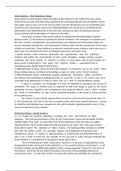Samenvatting
Urban Studies: summary of articles
- Vak
- Urban Studies
- Instelling
- Vrije Universiteit Amsterdam (VU)
Summary of all the articles which need to be read for the exam of Urban Studies, a subject given at the VU to anthropology students. Includes work from Lefebvre (2014), Low (1996), Certeau (2014), Freundendal-Pedersen (2015), Colombijn (2016), Jacobs (2014), Mitchell (2005), Datta (2014), Silver (2...
[Meer zien]




